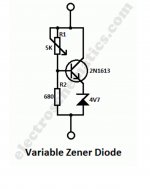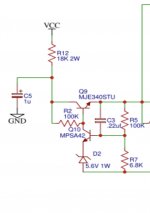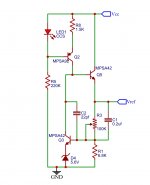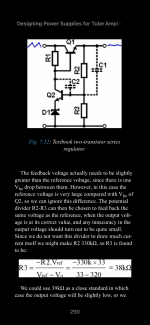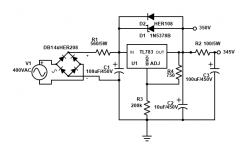Neat. One could possibly get reasonably close to zero temperature coefficient by choosing the zener diode carefully. I seem to recall that 5.6 V zeners have a roughly zero temperature coefficient. Zener diodes with a breakdown voltage below 5.6 V have a negative temperature coefficient. "Zener" diodes with a breakdown voltage above 5.6 V (actually relies on avalanche breakdown rather than zener breakdown) have a positive temperature coefficient.
Vbe has a negative temperature coefficient.
Tom
Vbe has a negative temperature coefficient.
Tom
Im looking for high voltage references without having to use gas tubes, and this is a perfect solution, I breadboarded something like this using a cheap 1W 5.6V zener, but added an additional pass device and resistor and made basically a reference regulator, making an ultrastable 100V reference, very nice!
TL431 is compact, temp. compensated and low dynamic impedance 'variable zener'. Beter in almost any aspects.
Only serious limitation is 37V limit, but there are workarounds.
Only serious limitation is 37V limit, but there are workarounds.
Last edited:
36-37V is fine for a reference for an HV power supply,one can just change the biasing and feedback scheme.
Without the zener and the pot and the 680Ω resistor swapped, this circuit serves in countless amplifiers as a bias network.Has anyone ever tried a variable zener setup?...
As a variable zener, there are many applications to be found. Your 100V regulator is ok, mind sharing the complete circuit?
Sure, Here is a 100V regulator for a discrete op amp that will be an error amplifier for a 300VDC preamp power supply, the Op Amp only draws about 6.5mA so the single MJE340 should be sufficient for a pass device. I use an 18K 2W resistor to drop the 300V to 150V before the regulator takes over. It won't be quite 100V exact, but close.
Attachments
Stupid question probably the wrong place to ask.
A regulator IC can pass a max off 1.5 amps i.e. 7812
If I were to use a 1 watt zener diode with a resistor. How much power would it handle in AMPs what is the formula.
A regulator IC can pass a max off 1.5 amps i.e. 7812
If I were to use a 1 watt zener diode with a resistor. How much power would it handle in AMPs what is the formula.
Ohm's Law VxI = P, where V is the zener breakdown voltage and I is the current passing through it.
As a bonus a nice preregulator low pass filter (18k/1µ0) at 10Hz....I use an 18K 2W resistor to drop the 300V to 150V ...
Given the 100k-6k8 divider, close to 100vdc is close enough.
I am unable to get my Positive rail voltage to match my negative voltage rail.
Wonder if this is a common reason why people prefer to use voltage regulation circuits ?. Just that I have not seen many chip amps use them.
Wonder if this is a common reason why people prefer to use voltage regulation circuits ?. Just that I have not seen many chip amps use them.
My current variable zener, I don’t know if I have the proper value for the zener shunt cap.
Vcc: 250-300VDC
Vref: 25-100VDC
Vcc: 250-300VDC
Vref: 25-100VDC
Attachments
Last edited:
Here's a regulator I use for making 400VAC into 330VDC... LM317 can be used if you replace 1N5378B with 1N5365B. R1 must drop the additional voltage. R4 can adjust the Vout.

Yes realistically those voltage ranges, actually C2 is the shunt, I got this suggestion from Merlin Blencowes book on power supplies.This circuit is adjustable between 97 to 6.2 Vdc. Is C1 your zener shunt?
Attachments
Curious, as I would expect C2 as a hf/early compensation. Though it is within the the loop gain amplification... Is a loop gain or pole/zero analysis available?
Can you supply the specs of HER108 & 1N5378~, or should I bother taking attemps finding?Here's a regulator ...
HER108 is a 1A diode sililar to UF4007. http://njsemi.com/datasheets/HER101 - HER108.pdf
1N5378B is a 5 watt 105V zener diode used to protect the TL783 from overvoltage but withstand charged capacitors feeding it. http://njsemi.com/datasheets/1N5333 - 1N5382.pdf
1N5378B is a 5 watt 105V zener diode used to protect the TL783 from overvoltage but withstand charged capacitors feeding it. http://njsemi.com/datasheets/1N5333 - 1N5382.pdf
Neat. One could possibly get reasonably close to zero temperature coefficient by choosing the zener diode carefully. I seem to recall that 5.6 V zeners have a roughly zero temperature coefficient. Zener diodes with a breakdown voltage below 5.6 V have a negative temperature coefficient. "Zener" diodes with a breakdown voltage above 5.6 V (actually relies on avalanche breakdown rather than zener breakdown) have a positive temperature coefficient.
Vbe has a negative temperature coefficient.
Tom
Ideally you would use a Zener diode that counteracts the temperature coefficient of the VBE junction of the pass transistor.
Yes this is true, but gas tubes like 85A2/STV85/10/5651 are some of the best references you can get for this type of thing, inexpensive too.36-37V is fine for a reference for an HV power supply,one can just change the biasing and feedback scheme.
Here's a regulator I use for making 400VAC into 330VDC... LM317 can be used if you replace 1N5378B with 1N5365B. R1 must drop the additional voltage. R4 can adjust the Vout.
View attachment 1135595
Bad schematic, C2 needs to be connected to the output terminal, otherwise R2 messes with the impedance of the output capacitor. Like implied above, this may cause the 783 to go unstable.
Cheers,
V4lve
- Home
- Amplifiers
- Power Supplies
- Variable Zener?
